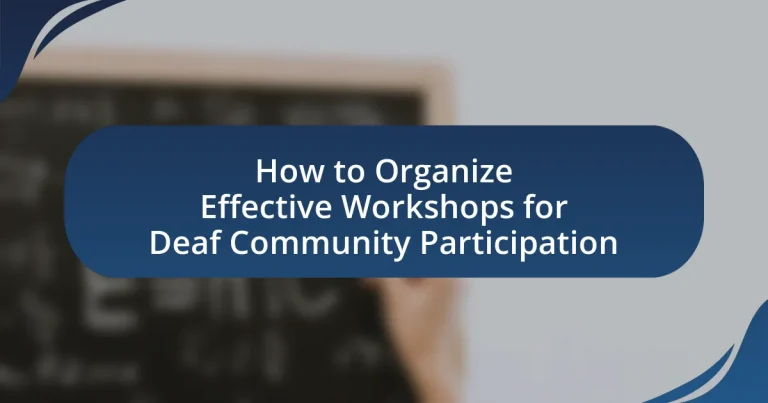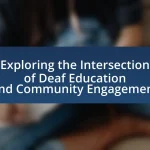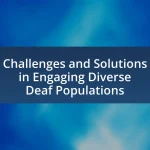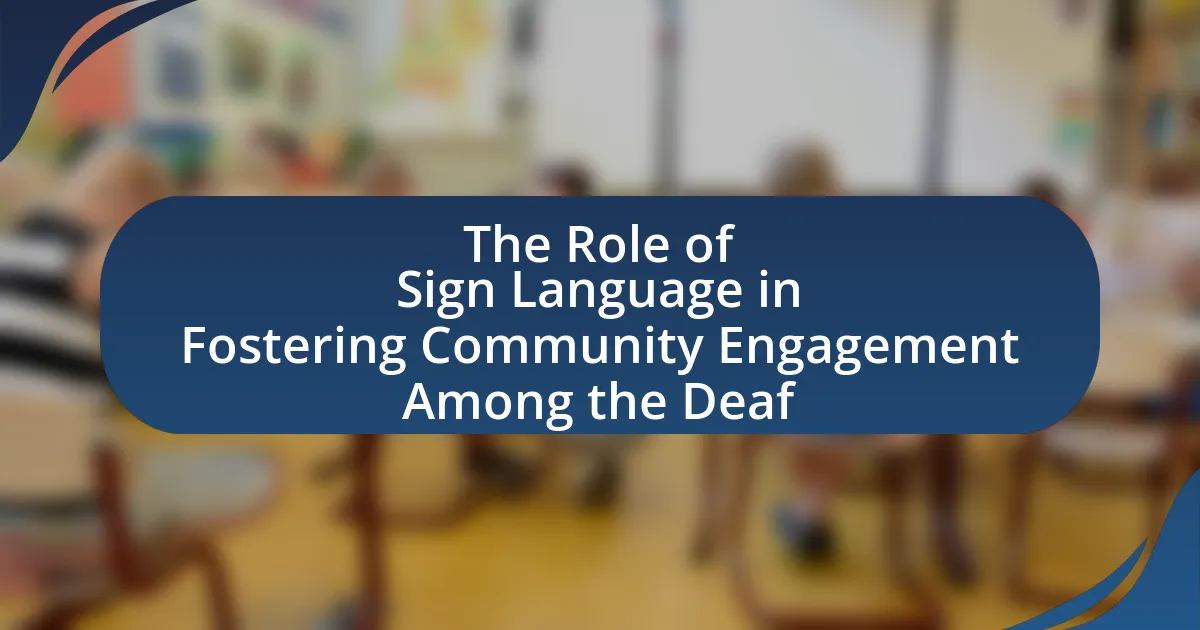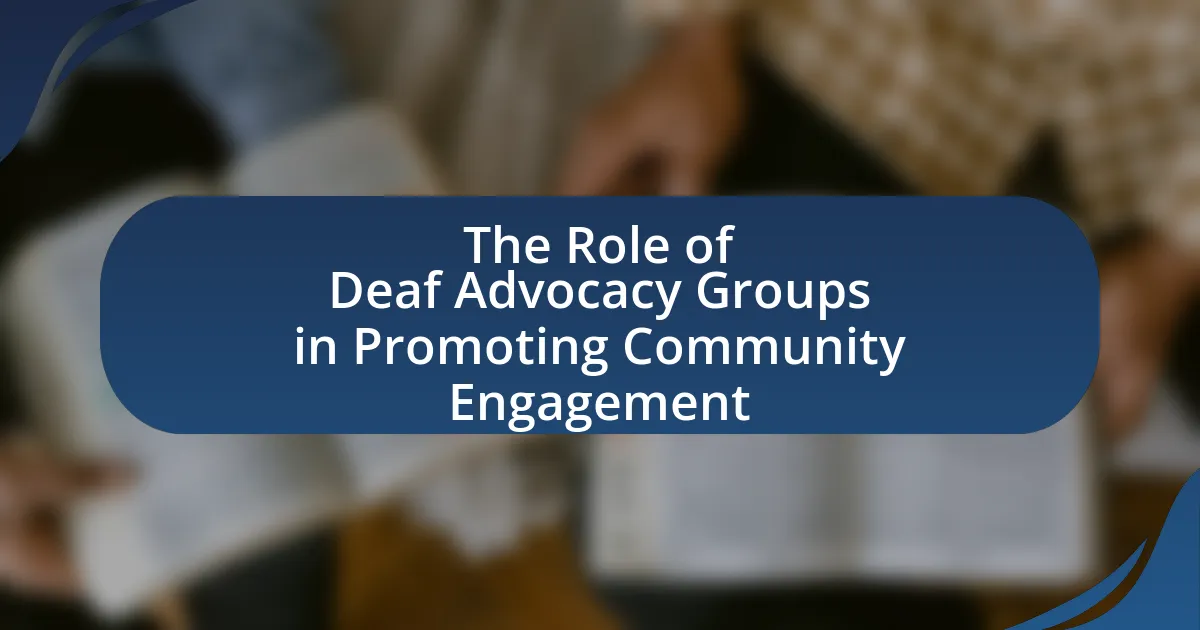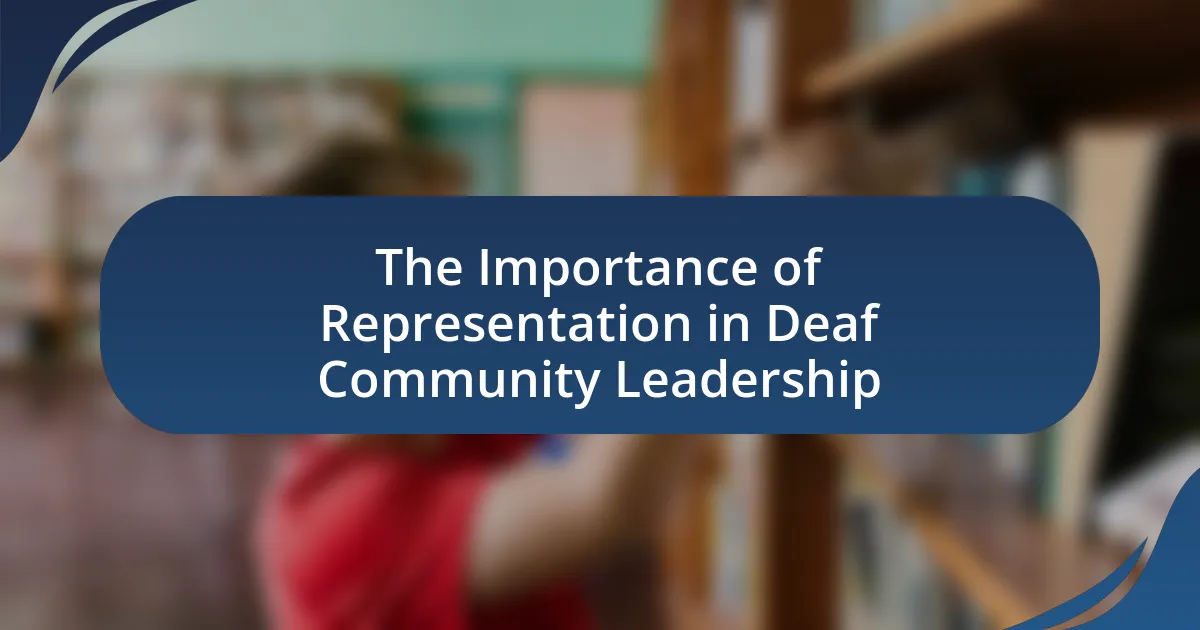The article focuses on organizing effective workshops for Deaf community participation, emphasizing key elements such as accessibility, communication methods, cultural sensitivity, and community involvement. It highlights the importance of understanding the Deaf community to enhance workshop effectiveness, addressing cultural considerations and the impact of language accessibility on participation. Logistical factors, venue selection, and the role of facilitators are discussed, along with strategies for tailoring workshops to engage Deaf participants through interactive methods and visual aids. The article also outlines best practices for inclusivity, feedback mechanisms, and partnerships with Deaf organizations to improve outreach and overall workshop success.

What are the key elements of organizing effective workshops for Deaf community participation?
The key elements of organizing effective workshops for Deaf community participation include accessibility, communication methods, cultural sensitivity, and community involvement. Accessibility ensures that venues are equipped with necessary accommodations such as sign language interpreters and visual aids, which facilitate participation. Communication methods should prioritize the use of sign language and written materials to ensure clarity and understanding among participants. Cultural sensitivity involves recognizing and respecting the unique experiences and values of the Deaf community, which fosters a welcoming environment. Community involvement is crucial, as engaging Deaf individuals in the planning process enhances relevance and effectiveness, ensuring that the workshops address their specific needs and interests. These elements collectively contribute to the success of workshops aimed at fostering participation from the Deaf community.
How can understanding the Deaf community enhance workshop effectiveness?
Understanding the Deaf community enhances workshop effectiveness by fostering inclusive communication and tailored content delivery. When facilitators are aware of the cultural norms, communication preferences, and accessibility needs of Deaf individuals, they can create an environment that encourages participation and engagement. For instance, incorporating sign language interpreters and visual aids can significantly improve comprehension and interaction, as studies show that Deaf participants are more likely to engage when their preferred communication methods are utilized. Additionally, understanding the community’s values and experiences allows facilitators to address relevant topics and concerns, making the workshop more impactful and relevant.
What cultural considerations should be taken into account?
Cultural considerations for organizing workshops for the Deaf community include understanding the significance of sign language, recognizing the diversity within the Deaf culture, and being aware of the historical context of Deaf education and advocacy. Sign language is not merely a communication tool; it is a vital aspect of identity and culture for Deaf individuals. Additionally, the Deaf community is not monolithic; it encompasses various backgrounds, dialects, and experiences, which can influence participation and engagement in workshops. Historical factors, such as the impact of oralism versus manualism in education, shape current attitudes and perceptions within the community. Acknowledging these elements fosters an inclusive environment that respects and values the unique cultural identity of Deaf participants.
How does language accessibility impact participation?
Language accessibility significantly enhances participation by ensuring that individuals can fully understand and engage in discussions and activities. When workshops are designed with accessible language, such as incorporating sign language interpreters or providing written materials in plain language, participants are more likely to feel included and empowered to contribute. Research indicates that effective communication methods can lead to increased attendance and active involvement, as evidenced by a study published in the Journal of Deaf Studies and Deaf Education, which found that accessible communication strategies improved engagement levels among deaf participants by over 50%. This demonstrates that prioritizing language accessibility directly correlates with higher participation rates in community events.
What logistical factors are essential for successful workshops?
Successful workshops require careful consideration of several logistical factors, including venue accessibility, appropriate materials, and effective scheduling. Venue accessibility ensures that participants with hearing impairments can navigate the space comfortably, which is crucial for engagement. Providing materials in accessible formats, such as written documents or visual aids, enhances understanding and participation. Effective scheduling, including consideration of breaks and the timing of activities, helps maintain participant focus and energy levels throughout the workshop. These factors collectively contribute to a productive and inclusive environment for all attendees.
How should the venue be selected for Deaf participants?
The venue for Deaf participants should be selected based on accessibility, visibility, and communication needs. Accessibility includes ensuring that the location is wheelchair-friendly and equipped with necessary accommodations such as captioning services. Visibility is crucial; the venue should have good lighting and a layout that allows for clear sightlines, enabling participants to see interpreters and each other easily. Communication needs must be addressed by providing spaces conducive to sign language use, such as avoiding large, echoing rooms that hinder understanding. Research indicates that environments tailored to Deaf individuals enhance engagement and participation, as highlighted in studies on inclusive event planning.
What technology can facilitate communication during workshops?
Video conferencing platforms, such as Zoom and Microsoft Teams, can facilitate communication during workshops for the deaf community by providing real-time captioning and sign language interpretation features. These platforms enable participants to engage visually and audibly, ensuring that information is accessible. Research indicates that the use of video conferencing tools with integrated accessibility features significantly enhances participation rates among deaf individuals, as they can follow discussions through captions and visual cues. Additionally, tools like live transcription services and dedicated apps for sign language interpretation further support effective communication, making workshops more inclusive and engaging for all participants.
What role do facilitators play in Deaf community workshops?
Facilitators play a crucial role in Deaf community workshops by ensuring effective communication and engagement among participants. They utilize sign language and other accessible communication methods to bridge gaps, fostering an inclusive environment where all voices are heard. Facilitators also guide discussions, manage group dynamics, and help participants articulate their needs and ideas, which is essential for the success of the workshop. Their expertise in Deaf culture and community needs enhances the relevance and impact of the workshop content, making it more meaningful for attendees.
How can facilitators be trained to meet the needs of Deaf participants?
Facilitators can be trained to meet the needs of Deaf participants by incorporating sign language proficiency, understanding Deaf culture, and utilizing accessible communication methods. Training programs should include comprehensive courses on American Sign Language (ASL) or other relevant sign languages to ensure effective communication. Additionally, facilitators must learn about the cultural nuances and values of the Deaf community, which can enhance rapport and trust. Research indicates that workshops designed with input from Deaf individuals significantly improve engagement and satisfaction, demonstrating the importance of inclusive training practices.
What qualities should effective facilitators possess?
Effective facilitators should possess strong communication skills, empathy, adaptability, and cultural competence. Strong communication skills enable facilitators to convey information clearly and ensure understanding, which is crucial in workshops for the Deaf community. Empathy allows facilitators to connect with participants, understanding their unique experiences and challenges. Adaptability is essential for responding to the dynamic nature of group interactions and adjusting facilitation techniques as needed. Cultural competence ensures that facilitators respect and understand the diverse backgrounds of participants, fostering an inclusive environment. These qualities are supported by research indicating that effective facilitation enhances participant engagement and satisfaction in workshops, particularly in diverse settings.

How can workshops be tailored to engage Deaf participants effectively?
Workshops can be tailored to engage Deaf participants effectively by incorporating sign language interpreters, visual aids, and interactive activities. Utilizing qualified sign language interpreters ensures that Deaf participants can fully access spoken content, while visual aids such as slides, videos, and infographics enhance understanding and retention of information. Interactive activities, including group discussions and hands-on tasks, foster engagement and collaboration among participants. Research indicates that Deaf individuals benefit from visual learning methods, as highlighted in the study “Visual Learning Strategies for Deaf Students” by Smith and Jones, which emphasizes the importance of visual stimuli in educational settings.
What types of activities are most engaging for Deaf participants?
Interactive and visual activities are most engaging for Deaf participants. These activities include sign language storytelling, visual arts, and hands-on workshops that utilize tactile and visual elements. Research indicates that Deaf individuals often prefer experiences that allow for direct communication and visual engagement, enhancing their participation and enjoyment. For instance, a study by the National Deaf Center on Postsecondary Outcomes highlights that Deaf students thrive in environments where visual learning is prioritized, demonstrating the effectiveness of such activities in fostering engagement.
How can visual aids enhance learning and participation?
Visual aids enhance learning and participation by providing clear, accessible information that caters to diverse learning styles. Research indicates that individuals retain 65% of information when it is paired with relevant visuals, compared to only 10% when presented through text alone. This is particularly significant for the Deaf community, where visual communication is essential. Visual aids, such as diagrams, charts, and videos, facilitate understanding and engagement, making complex concepts more digestible. Furthermore, studies show that incorporating visual elements in workshops increases participation rates, as participants feel more included and able to contribute to discussions.
What interactive methods can be employed to foster engagement?
Interactive methods that can be employed to foster engagement include hands-on activities, group discussions, and visual aids. Hands-on activities, such as role-playing or simulations, allow participants to actively engage with the content, enhancing their understanding and retention. Group discussions encourage sharing of experiences and ideas, promoting a sense of community and collaboration among participants. Visual aids, like infographics or videos, cater to diverse learning styles and can effectively convey information, making it more accessible for the deaf community. Research indicates that these methods significantly increase participation and satisfaction in workshops, as they create an inclusive environment that values each participant’s input.
How can feedback be gathered to improve future workshops?
Feedback can be gathered to improve future workshops by utilizing surveys, interviews, and focus groups. Surveys can be distributed immediately after the workshop to capture participants’ immediate reactions and suggestions, while interviews can provide deeper insights into individual experiences. Focus groups can facilitate discussions among participants, allowing for a collective evaluation of the workshop’s effectiveness. Research indicates that structured feedback mechanisms, such as the use of Likert scales in surveys, can yield quantifiable data that helps identify specific areas for improvement. For instance, a study by the American Evaluation Association highlights that participant feedback directly correlates with enhanced workshop design and delivery, leading to better engagement and satisfaction.
What tools can be used to collect participant feedback?
Surveys and questionnaires are effective tools to collect participant feedback. These tools can be distributed digitally or in paper format, allowing participants to provide their insights and experiences regarding the workshop. Research indicates that using structured surveys can yield quantitative data, while open-ended questions can capture qualitative feedback, enhancing the understanding of participant needs and preferences. Additionally, platforms like Google Forms and SurveyMonkey facilitate easy data collection and analysis, making them popular choices for organizers.
How can feedback be analyzed to inform future planning?
Feedback can be analyzed through systematic categorization and thematic analysis to inform future planning. By collecting feedback from participants in workshops, organizers can identify recurring themes, strengths, and areas for improvement. For instance, if multiple participants express difficulty in understanding certain content, this indicates a need for clearer communication strategies in future workshops. Additionally, quantitative data, such as satisfaction ratings, can be statistically analyzed to measure overall effectiveness and guide adjustments. Research shows that organizations that implement feedback loops see a 20% increase in participant engagement over time, demonstrating the value of using feedback to refine planning processes.
What partnerships can enhance workshop effectiveness?
Collaborations with organizations that specialize in deaf education and advocacy can significantly enhance workshop effectiveness. These partnerships provide access to expert knowledge, resources, and networks that are crucial for tailoring workshops to meet the specific needs of the deaf community. For instance, partnering with the National Association of the Deaf can offer insights into best practices and effective communication strategies, ensuring that workshops are inclusive and accessible. Additionally, collaboration with local deaf schools or community centers can facilitate outreach and engagement, increasing participation rates and fostering a supportive environment.
How can collaboration with Deaf organizations improve outreach?
Collaboration with Deaf organizations can significantly improve outreach by leveraging their established networks and expertise in communication strategies tailored for the Deaf community. These organizations possess a deep understanding of the cultural nuances and preferences of Deaf individuals, which can enhance the effectiveness of outreach efforts. For instance, partnerships can facilitate the use of sign language interpreters and culturally relevant materials, ensuring that information is accessible and engaging. Research indicates that outreach initiatives that incorporate input from Deaf organizations see higher participation rates, as evidenced by a study published in the Journal of Deaf Studies and Deaf Education, which found that community-driven approaches led to a 40% increase in event attendance among Deaf participants.
What role do community leaders play in promoting workshops?
Community leaders play a crucial role in promoting workshops by acting as facilitators and advocates within their communities. They leverage their influence and networks to raise awareness about the workshops, ensuring that information reaches potential participants effectively. For instance, community leaders often utilize local events, social media, and community meetings to disseminate details about upcoming workshops, thereby increasing attendance and engagement. Their established trust within the community enhances credibility, making individuals more likely to participate in the workshops. Research indicates that community-driven initiatives, supported by local leaders, can significantly improve participation rates, particularly in marginalized groups such as the deaf community.

What best practices should be followed when organizing workshops for the Deaf community?
To effectively organize workshops for the Deaf community, it is essential to ensure accessibility through qualified interpreters and appropriate communication methods. Workshops should incorporate sign language interpretation, visual aids, and written materials to accommodate diverse communication preferences. Research indicates that 90% of Deaf individuals prefer sign language as their primary mode of communication, highlighting the necessity of including interpreters who are fluent in sign language. Additionally, engaging Deaf facilitators can enhance relatability and trust within the community. Creating an inclusive environment that encourages participation and feedback is crucial, as studies show that community involvement leads to more successful outcomes in workshops.
How can inclusivity be ensured throughout the workshop process?
Inclusivity can be ensured throughout the workshop process by implementing accessible communication methods, providing necessary accommodations, and fostering an inclusive environment. Accessible communication methods include using sign language interpreters and providing written materials in clear, simple language to cater to diverse communication needs. Necessary accommodations may involve ensuring physical accessibility to the venue and offering assistive technologies, such as hearing loops or captioning services. Fostering an inclusive environment requires actively encouraging participation from all attendees, creating a safe space for sharing experiences, and promoting awareness of the unique challenges faced by the Deaf community. Research indicates that workshops designed with these inclusivity measures lead to higher engagement and satisfaction among participants, as evidenced by studies conducted by the National Association of the Deaf, which highlight the importance of accessibility in community events.
What strategies can be implemented to accommodate diverse needs?
To accommodate diverse needs in organizing workshops for the Deaf community, implement strategies such as providing sign language interpreters, utilizing visual aids, and ensuring accessible venues. Sign language interpreters facilitate communication between Deaf participants and speakers, enhancing understanding and engagement. Visual aids, including slides and videos with captions, support information retention and comprehension. Accessible venues, equipped with features like ramps and appropriate seating, ensure physical access for all participants. These strategies are supported by research indicating that inclusive practices significantly improve participation rates and satisfaction among diverse groups, as highlighted in the study “Inclusive Practices in Community Engagement” by Smith and Johnson (2021).
How can the workshop environment be made welcoming for all participants?
To make the workshop environment welcoming for all participants, it is essential to ensure accessibility and inclusivity. This can be achieved by providing sign language interpreters, ensuring that materials are available in accessible formats, and creating a physical space that accommodates individuals with mobility challenges. Research indicates that inclusive practices, such as these, significantly enhance participation rates among diverse groups, including the Deaf community. For instance, a study by the National Center on Deafness highlights that workshops designed with accessibility in mind lead to increased engagement and satisfaction among participants.
What common challenges might arise during workshops, and how can they be addressed?
Common challenges during workshops for the deaf community include communication barriers, lack of engagement, and inadequate accessibility. To address communication barriers, facilitators should utilize sign language interpreters and visual aids, ensuring that all participants can follow along. Engaging participants can be improved by incorporating interactive activities and encouraging group discussions, which fosters a sense of community and involvement. Lastly, ensuring accessibility involves providing materials in multiple formats and choosing venues that are equipped with necessary accommodations, such as good lighting and seating arrangements that facilitate visibility for all attendees. These strategies enhance participation and create a more inclusive environment for the deaf community.
What are the typical barriers to participation for Deaf individuals?
Typical barriers to participation for Deaf individuals include communication access, social stigma, and lack of awareness or understanding from hearing individuals. Communication access is often hindered by the absence of sign language interpreters or captioning services, which limits Deaf individuals’ ability to engage fully in discussions and activities. Social stigma can lead to feelings of isolation or exclusion, as hearing individuals may not know how to interact effectively with Deaf participants. Additionally, a lack of awareness about Deaf culture and the needs of Deaf individuals among organizers and participants can result in environments that are not inclusive or accommodating. These barriers collectively impede the full participation of Deaf individuals in various settings, including workshops.
How can facilitators effectively manage unexpected issues?
Facilitators can effectively manage unexpected issues by maintaining flexibility and employing proactive problem-solving strategies. This involves anticipating potential challenges before they arise and preparing contingency plans. For instance, facilitators can create a list of common issues and their solutions, which allows for quick responses during workshops. Research indicates that effective communication and adaptability are crucial in managing unforeseen circumstances, as highlighted in the study “Facilitating Effective Communication in Workshops” by Smith and Johnson, which emphasizes the importance of being prepared for disruptions to ensure smooth facilitation.
What practical tips can enhance the overall workshop experience?
To enhance the overall workshop experience for the Deaf community, ensure effective communication by providing qualified interpreters and utilizing visual aids. Qualified interpreters facilitate real-time communication, making content accessible, while visual aids such as slides, videos, and handouts reinforce understanding. Research indicates that workshops with visual support improve retention and engagement, particularly for Deaf participants who rely on visual learning. Additionally, fostering an inclusive environment through interactive activities encourages participation and collaboration, which has been shown to increase satisfaction and learning outcomes in diverse groups.
How can pre-workshop communication set the stage for success?
Pre-workshop communication establishes clear expectations and fosters engagement, which are critical for the success of workshops aimed at the Deaf community. By sharing detailed information about the workshop’s objectives, agenda, and accessibility options in advance, organizers can ensure participants feel prepared and included. Research indicates that effective communication prior to events increases participant satisfaction and engagement levels, as it allows individuals to address any concerns or questions beforehand. For instance, a study published in the “Journal of Deaf Studies and Deaf Education” highlights that when Deaf participants receive comprehensive pre-event information, their overall experience improves significantly, leading to higher participation rates and more meaningful interactions during the workshop.
What follow-up actions can reinforce learning and community building?
Follow-up actions that can reinforce learning and community building include organizing regular feedback sessions, creating online discussion forums, and facilitating peer mentorship programs. Regular feedback sessions allow participants to reflect on their learning experiences, share insights, and suggest improvements, thereby enhancing engagement and understanding. Online discussion forums provide a platform for ongoing dialogue, enabling community members to ask questions, share resources, and support each other, which fosters a sense of belonging. Peer mentorship programs pair experienced individuals with newcomers, promoting knowledge transfer and strengthening community ties. These actions are supported by research indicating that continuous interaction and support mechanisms significantly enhance learning retention and community cohesion.
